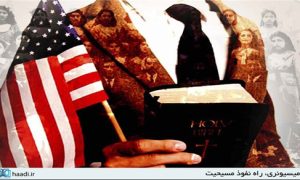One of the oldest way of the bond between the Baha’is and the American is their cooperation with the evangelical American missioners (the Christian proselytizers) and their related institutes in Iran. Arthur Hardinge said: “(the Christian) American proselytizers residing in Iran believed that the future of the religion of this country belongs to the Babis.”
۱) Culture, the Trojan Horse of policy
The political nature and aims of the institutes related to the American evangelicals, even their so-called educational and scientific ones are not secret. For instance, the American college Alborz which belong to the American evangelical missioners since Qajar dynasty to 1319 S.H. and was administered under the supervision of Dr. Jordan and his wife (Later on, it was bought the Iranian government and was headed by merited men like Dr. Mojtahedi).
Mr. Ali Akbar Kothari, one of the cultural persons in charge in Pahlavi era says: “the American college Alborz in Tehran which was managed by Dr. Arthur Jordan was founded by the American religious missioners funded also by them. The American missioners established the school to preach Christianity. I remember one of the founders of college had said: That American old woman who is helping the school financially hopes some people in a year turn to Christianity. So that, I know some students such as Amir Birjandi, Jahangiri or Jahanshah Saleh became Christian just because they use college facilities more. When we spoke with them they were saying they were Muslims. As a matter of fact, such people didn’t bond with any religion. Of course, Jahanshah Saleh became so close with America that he became one of the members of CIA…”[۱]
The foreign schools in Fran during Qajar and Pahlavi eras were leading Iranian and Muslim students towards being separated from Islamic and national culture,[2] but this movement was more severe in American school of 131 Tehran city.[3] Campaigning against the Islamic principle of vailing of ladies was of the affairs pursued by these school seriously.
Henry Rene D’ Allemagne, the French agent stipulates this issue.[4] The influence of anti-Islamic thoughts of this school on Muslim Iranian girls can be observed in the articles of the magazine. “the women world” published during the years 1290 to 1313 S.H. under the supervision of the assembly of the graduated of the highest school of the American ladies of Iran in the capital city of Islamic Iran. It tried to lead the Iranian family towards the western model[5] and had changed the proselytizing for the western civilization and the absolute equality between men and women and campaigned against the vailing as one of the most basic issues of the magazine.
۲) Evangelism; the forerunner of the influence and dominance of Colonialism:
The mission of evangelical missioners in Iran and other Islamic lands and supporting them by Colonialism financially, politically wasn’t merely the expansion of Christianity creed among people and Colonial aims of the western governments shouldn’t be ignored. Dr. Omar Faroukh (the researcher from Lebanon) has shown the political and Colonial aims of the evangelists and their supporters using valid documents in the book “Evangelism and Colonialism” translated and published by the name of “the role of church in the Islamic lands” by late Mostafa Zamani. Concerning the American missioner’s activities in Iran, the speech by Wipert Blucher, the German ambassador in Iran are short but illustrative: “The most important factor for the influence of America was the board of American Christian proselytizers.”[۶]
۳) A Baha’i in the American school of Urmia
Vahid Kashifi (Mirza Yousof Khan Lesan Hozour, one of the Baha’i proselytizers during Qajar era. He is Seyyed Yahya Kashfi Darabi’s niece (one of the activists of Bahaism) who was cooperating with the American evangelical missionaries. When Muhammad Ali Shah visited the American college and hospital Urmia in 1319 S.H. ( when he was prince), vahid Kashfi made a 30-min speech about the history of establishing school and hospital and the services of American missionaries in Iran.”[7]
In 1320 S.H., Vahid went to America ordered by Abbas Effendi and traveled to the cities of that country (New York, Washington and etc.). He returned to Iran after residing there for a year and a half and was employed in the American school at which he was busy before.
Urmia was first city in which the American Christians proselytized against Islam!”[8]
[۱] Narrated by Ali Akbar Kowthari, dialogue: Morteza Rasouli, written in contemporary history of Iran, No. 13 & 14, spring and summer 1379 S.H., p.362.
[۲] Refer to the memoires and documents of Zahirudduleh, attempted by Iraj Afshar, p.303.
[۳] Lifetime disasters, The Iranian history publication, p.132.
[۴] The itinerary from Khorasan to Bakhtiari, translated and written by Farhoushi, pp. 293-294.
[۵] cloth and textile mode, Habibeh Mojallal, written in women’s world, Year 8, No. 1, Day 1306 S.H., p. 32.
[۶] Blusher’s itinerary, translated by Keykavous Jahandari, P.193.
[۷] Ahang-e-Badia, Year 9, No.11, pp. 254&255.
[۸] Eagle and lion…. James Bill, translated by Mahvash Gholami, pp. 25-27.






